


For example, entering "Android" will return all entries that contain the substring "Android".

You will make a copy of the finished WordListSQLInteractive app (or WordListSqlStarterCode if you didn't rename it from a previous practical), call it WordListSQLInteractiveWithSearch, and add an activity that lets users search for partial and full words in the database. Note: The focus of this practical is not optimizing the UX of the search request, but showing you how to query the database. Why: Users should always be able to search the data on their own terms. In this practical you will add an item to the options menu for searching the database, and an activity that allows users to enter a search string and displays the result of the search in a text view. Build search queries for the SQLite database from user input.Add search functionality to your app via the options menu.10.1B: Searching a SQLite Databaseįor this practical you should be familiar with: This course is now deprecated and this content will be

The new course is available atĪndroid Developer Fundamentals course (Version 2), or go directly to Lesson 11: Sharing Data with Content Providersġ1.1A: Implementing a Minimalist Content Providerġ1.1B: Adding a Content Provider to Your Databaseġ2.1: Loading and Displaying Fetched DataĪ new version of this course is now available, updated to reflectīest practices for more recent versions of the Android framework andĪndroid Studio. Lesson 8: Triggering, Scheduling, and Optimizing Background Tasks Lesson 3: Testing, Debugging, and Using Support LibrariesĤ.1: Using Keyboards, Input Controls, Alerts, and PickersĤ.2: Using an Options Menu and Radio ButtonsĤ.3: Using the App Bar and Tabs for Navigationĥ.2: Material Design: Lists, Cards, and Colorsĥ.3: Supporting Landscape, Multiple Screen Sizes, and Localizationħ.2: Connect to the Internet with AsyncTask and AsyncTaskLoader 1.1: Install Android Studio and Run Hello World


 0 kommentar(er)
0 kommentar(er)
